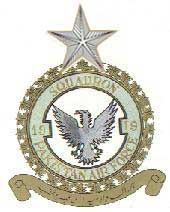|
No 19 Air Superiority Squadron was raised on 1st February 1958 at Mauripur with twelve F-86F aircraft. It started its operational training for its assigned role of day air defence and close support under its first commander Squadron Leader Amanullah Khan. The Squadron achieved first position among F-86 squadrons in the Perry-Keene armament competition held in February 1962.
Also in 1962, a flight of 4 Sabres was sent to Dhaka on a trial assignment. By October the Squadron move had been completed with another's flight of 4 aircraft followed by a pair while 2 aircraft were sent by ship. At Dhaka the Squadron became deeply involved in tackling the teething problems in the exciting new environment. The move had generated great enthusiasm among the masses at Dhaka who thronged the air base at Tejgaon to see the shiny fighter planes.
The Squadron was originally planned to be moved back to West Pakistan before the monsoon storms but the squadron commander, Squadron Leader Wiqar Azim represented to the C-in-C, who was passing through Dhaka in a B-57 on his way to a SEATO meeting in Bangkok, that the squadron should stay on through the monsoon weather and establish the precautionary measures and systems which would enable Tejgaon to become a permanent operational air base. The C-in-C agreed and 19 Squadron continued its stay in Dhaka. It was thus also able to stage the first jet aircraft fly past over Dhaka during the Pakistan Day ceremonies on 23rd March 1963.
In October 1963, the squadron moved to Peshawar from where it saw action in the September 1965 war with India. On 6th September it carried out some of the first close air support missions on the Wagah front and helped avert an Indian army offensive across the BRB canal. Late that evening, 19 Squadron struck Pathankot airfield as part of the PAF's counter air offensive. By the end of the war the squadron had flown 706 hours in 554 sorties without losing a single aircraft or pilot. It had destroyed 14 enemy aircraft, 74 tanks, 140 vehicles and 16 guns, and damaged 16 aircraft, 68 tanks, 128 vehicles and 27 guns. For this outstanding performance the officer commanding, Squadron Leader S S Haider was awarded the Sitara-i-Juraat.
In June 1967, the squadron was moved to PAF Base, Masroor where, just before the 1971 war some F-86E aircraft were inducted into the unit. The day air defence of the southern sector with a mixture of Fs and Es was successful as was close air support in the Rajasthan sector inspite of communication difficulties with the forward air controllers. Overall, in its limited operations the squadron destroyed 2 Indian Air Force Hunters, one Mi-4 helicopter and damaged one Hunter. In addition, 8 enemy tanks and several vehicles were destroyed while 2 trains were set ablaze during close support missions. The Squadron suffered only one casualty when Flying Officer Naseem Nisar Ali was shot down by an Indian Air Force Hunter.
On 10th November 1972, the Squadron was converted into Fighter Leaders School. In 1977 it was reequipped with F-6 aircraft and designated as No 19 Air Superiority Squadron; the unit was assigned the role of day interceptor and close support and was moved to PAF Base, Sargodha. A year later, the Squadron demonstrated its proficiency on the new type of aircraft by winning the armament competition trophy for 1978. The squadron also had the honour of representing the PAF in an Iran-Pakistan armament competition held at Vahdati air base in Iran in September 78. In 1979 it displayed outstanding professionalism in exercise Jetstream and won the Professionals Trophy. |

